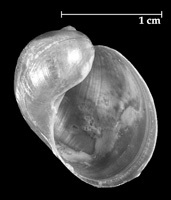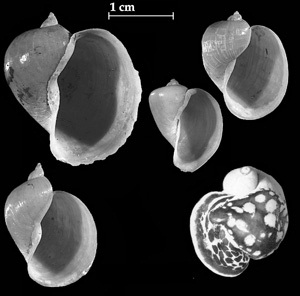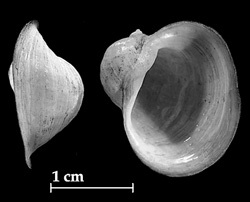Freshwater snails » Shell shape » Shell taller than wide » Dextral shell » Family: Lymnaeidae (1) » Lymnaeidae with short spires (2) »
The shells of this family do not possess an operculum. Many empty freshwater snail shells may be found without an operculum. If your specimen does not have an operculum and does not match the shape and/or descriptions on the following pages, please go back and try the group with an operculum.
In Europe, three species of the family have very short spires: Myxas glutinosa, Radix auricularia and R. ampla. Of these, R. ampla has so far not been recorded in Great Britain and Ireland, but is suspected to be possibly present and overlooked. The details of this species are therefore included here so that it may be further investigated. Any sightings of live specimens which match the description and illustrations below of R. ampla should be immediately reported to the national non-marine recorder, who will advise the best method of proceeding.

Myxas glutinosa
(Müller, 1774)
Genus: MYXAS Sowerby, 1882
In the live animal the mantle covers the shell almost completely. Only one species occurs in northern Europe.
Myxas glutinosa (Müller, 1774)
Description: The shell is very thin, transparent and fragile. It is almost globular in shape with a short blunt spire and a greatly inflated oval aperture. The mantle covers the shell completely except for a small oval space on the upper side of the last whorl.
Size: Height: 13 – 15 mm. Breadth: 10 – 12 mm.
Habitat: It is rare and local, and there have been very few records in Britain since the 1950's. It inhabits the larger bodies of quiet, very clean water, avoiding turbid and weedy places and prefers hard substrates.
Genus: RADIX Montford, 1810
A very variable genus, which appears to respond in the shape of its shell to a number of factors, including environmental influences. It is, therefore, not surprising that a number of superficially dissimilar forms result, sometimes varying from pond to pond within close proximity. Nevertheless, enough shell characters remain constant for positive identification in most cases, without having to resort to dissection.
Two species are recognised as occurring in Britain, the first of which has a very short spire, R. auricularia, which is described below. The species with a tall spire is R. balthica, details of which may be seen by using the name to link to the page.
A third species R. ampla has NOT been recorded in Britain or Ireland, but is thought to possibly be present and to have been overlooked due to its similarity to R. auricularia. The details of this species are also included below so that it may be investigated further. Any sightings of live specimens which match the description and illustrations below of R. ampla should be immediately reported to the national non-marine recorder, who will advise the best method of proceeding.

Radix auricularia (Linnaeus, 1758)
(The image bottom right illustrates
the mantle after the shell has been removed)
Radix auricularia (Linnaeus, 1758)
Description: The shell is thin walled and glossy. It is yellow- horn coloured with 4 - 5 whorls, the last of which expands rapidly and is very tumid. This body whorl forms at least five-sixths of the entire height of the shell. The spire is short and pointed, and is sometimes sunken so as to be almost level with the top of the body whorl. The upper edge of the mouth aperture meets the body of the shell at a right angle. The umbilicus is reduced to a mere chink.
Size: Height: 18 – 35 mm. Breadth: 16 – 30 mm.
Habitat: It is generally distributed in canals, rivers and lakes throughout England and Wales, and also in the lowlands of Scotland. It is possibly under recorded in Ireland, where there are few recent records outside the Lough Neagh area.
For shell characters separating this species from R. ampla see below

Radix ampla
(Hartmann 1821)
Radix ampla (Hartmann, 1821)
Description: The spire is very short and pointed. The aperture is extremely inflated and extends almost level with the apex of the spire, occasionally higher. The mouth edge is slightly reflected in mature specimens. The body whorl is especially tumid, almost globular. The columella does not bear the fold which is chacteristic of other Radix species.
The most noticeable differences from R. auricularia are the lack of a columella fold and the fact that the aperture extends up to nearly level with the apex of the spire, or higher.
Size: Height: 20 mm. Breadth: 19 mm.
Habitat: Quiet, well vegetated edges of small rivers and large lakes, often in the very shallow water.
